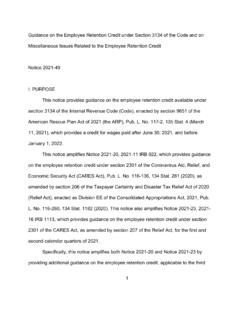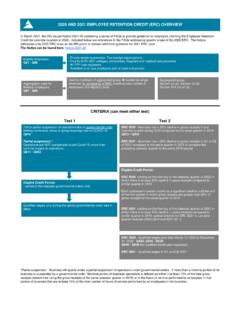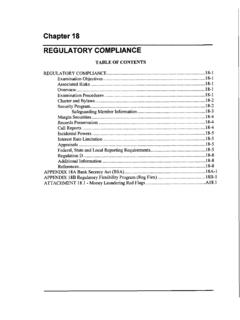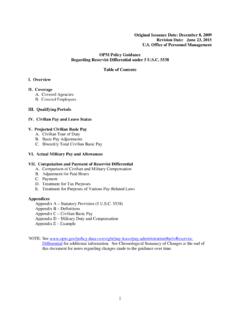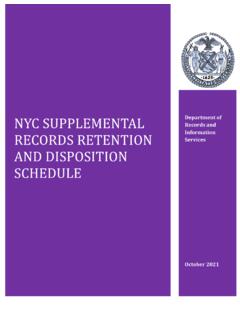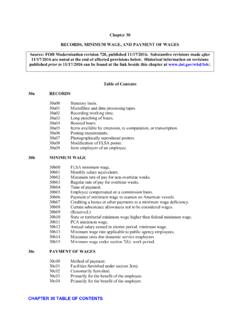Transcription of On-the-Job Training (OJT) Guidance Manual
1 On-the-Job Training (OJT) Guidance Manual A Supplement to WFC WIOA Policy #1006 WIOA OJT Policy and Procedures Revised June, 2016 WFC OJT Policy Manual Page 2 of 55 Revised June, 2016 TABLE OF CONTENTS I. 4 II. THE FUNDAMENTALS OF 4 A. On-the-Job Training (OJT).. 4 B. Demand for Occupation in the Labor 5 C. Exceptions to Demand Occupations .. 5 III. SELECTION OF 6 A. Eligible 6 B. Employer 6 IV. TRAINEE 6 A. Documenting Need-Individual Service Plan (IEP)/Individual Service Strategy (ISS).. 6 B. Participants with Previous Experience in the 6 C. Previous Employer of 7 D.
2 Currently Employed Workers; 7 E. Assessment 7 V. QUALIFYING THE 8 A. The Initial 8 B. Appropriate 8 C. Participating Employer s Trainee Retention 8 D. Disproportionate Share of the Work 9 E. Work Opportunity Tax Credit (WOTC).. 9 F. Conflict of 9 VI. THE OJT CONTRACT 10 A. Starting 10 B. Limitations on Annual Training 10 C. Determining Training Duration-Specific Vocational Preparation (SVP).. 10 D. The Training 11 E. Supplemental Training and Supportive 12 F. Collective 13 G. Modifications and 13 H. 14 I. 14 J. Employer 14 VII. PARTICIPANT 15 A. Participant 15 VIII.
3 EMPLOYER 15 IX. REIMBURSEMENT 16 A. Time and 16 B. 16 C. Trainee Termination Prior to Training 16 D. Holidays, Vacation and Sick 16 WFC OJT Policy Manual Page 3 of 55 Revised June, 2016 E. 17 F. Pay 17 G. Monthly Salary 17 X. MONITORING AND 18 A. 18 B. 18 XI. ADDITIONAL OJT RESOURCES & 18 A. OJT 18 B. Career 18 C. O* 19 D. Occupational Outlook 19 E. Job 19 F. Occupation Tasks, Knowledge Skills and Abilities, Tools and Technology, Work Activities, Wages and Employment 19 G. Fastest Growing 19 H. Skills Gap 19 I. Training Plans 19 J. 19 K. 20 On-the-Job Training SAMPLE 21 WIOA OJT Policy # 22 OJT Employer Pre-Screening 28 WFC OJT 32 OJT Supplemental Training 43 OJT Exception 45 OJT Reimbursement 46 OJT Tool and Equipment 49 Participant File Documentation 51 Employer File Documentation 52 OJT Monitoring 53 WFC OJT Policy Manual Page 4 of 55 Revised June, 2016 I.
4 INTRODUCTION WorkForce Central (WFC) administers a comprehensive employment and Training program that utilizes various employment and Training activities authorized under the Workforce Innovation and Opportunity Act (WIOA) to systematically develop the employability of eligible youth, dislocated workers and adults and, when appropriate, to place them into jobs. On-the-Job Training (OJT), when properly implemented, serves this purpose very effectively because a Trainee is hired into a job, or their current job is upgraded, while being trained in the new job s requisite skills. While the WIOA law contains a number of provisions that broadly define OJT and prohibit various practices, many of the parameters of this activity have been left to local definition.
5 This Manual consolidates the policies and procedures that are to be used by WFC staff and service providers and provides Guidance in the development, negotiation, implementation, and monitoring of OJT Contract packages. II. THE FUNDAMENTALS OF OJTS A. On-the-Job Training (OJT) OJT is a strategic employment service that supports the business community in their hiring process by adding staff capacity, productivity and Training at reduced costs to the Employer and is an excellent vehicle for eligible Job Seekers to build their skills and re-establish their employment status. OJT benefits Employers by reducing the cost of Training new employees, the Employer designs the on-site Training , Training is aligned with the skills required for the job and is a long term investment in the company.
6 OJT benefits the Job Seeker by providing an opportunity to earn as they learn in a hands-on environment, acquire job and career advancement skills, and provides an opportunity for long-term employment. The basic purpose of an OJT is to encourage public, private non-profit or private Employers to hire an individual, or upgrade an eligible employed worker, who would not otherwise qualify for the job and to teach the skills requisite to perform at the job. The OJT Service Provider provides the Employer with a partial wage reimbursement for an agreed-upon Training time period in exchange for the provision of Training by the Employer and a commitment to retain the individual when the Training is successfully completed.
7 OJT is a hire-first program. The Trainee is a full-time, regular employee of the company that has agreed to provide the Training . WFC defines full-time, regular employee to equal no less than 35 hours per week. OJT Training payments to Employers are deemed to be compensation to the Employer for the extraordinary costs associated with Training participants and the costs associated with the lower productivity of the participants during the Training period. Employers are not required to document such extraordinary costs [proposed rule at 20 CFR (c)]. Per WFC policy, Employers may be reimbursed up to 50 percent, 65 percent or 75 percent of the wage rate of an OJT participant for the costs of providing the Training and additional supervision related to the OJT.
8 Subject to funding availability and the OJT Trainee s needs, WorkForce Central limits the cost of OJTs to $5,000 for jobs paying entry level wages and $6,000 for higher wage jobs and the Training duration to not less than four weeks and not more than 26 weeks. Training duration must be in line with Specific Vocational Preparation (SVP) estimates (Refer to section VI. C. Determining Training Duration-Specific Vocational Preparation). Subsidized employment programs such as Work Experiences, paid internships or other limited duration placements for qualified participants are different from OJT primarily because they do not require the participant to be an employee of the company participating in the activity.
9 Nor do the activities require the Employer to continue to employ the participant at the conclusion of the subsidized Training activity. WFC OJT Policy Manual Page 5 of 55 Revised June, 2016 Because all new employees undergo some form of Training , it is essential to differentiate the initial " Training and orientation" routinely provided by the Employer to qualified new hires from the additional Training that is to be provided for the OJT Trainee. The Employer should only be compensated for Training that is in addition to what is normally provided to a qualified new employee. During the course of the OJT, the Trainee must be treated as a regular employee and should receive wages and benefits at the same level as similarly employed workers [proposed rule at 20 CFR (a)] Not all jobs are appropriate for OJT.
10 The emphasis on Training automatically eliminates all jobs that require no more than a brief initial orientation period. Similarly, because reimbursements are intended to compensate the Employer for decreased productivity, jobs that pay by commission or piecework are generally considered inappropriate. Additionally, seasonal, temporary and part-time jobs should likewise be avoided because the desired outcome of OJT is long-term retention into full-time employment that leads to self-sufficiency. The assessment process is used to substantiate that each Trainee has a need for the Training that is to be provided and has the capability to benefit from this Training .




